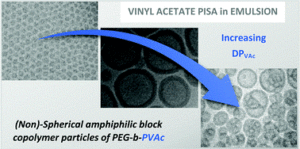D’Agosto, Lansalot and co-workers report the synthesis of nanoparticles with various shapes through the RAFT/MADIX PISA polymerization of vinyl acetate.
Polymerization-induced self-assembly (PISA) is a widely used technique that allows access to the formation of a range of polymeric nanoparticles including spheres, worms and vesicles. Although this methodology has been very successful with dispersion polymerizations, emulsion polymerization systems are mostly limited to the preparation of spherical particles. Poly(vinyl acetate) latexes are obtained by emulsion polymerization and find use in many industrial applications but yet, the preparation of higher ordered morphologies remains challenging. D’Agosto, Lansalot and co-workers were able to circumvent this by conducting the emulsion polymerization of vinyl acetate at higher temperatures anticipating that this would not only lead to much faster reaction kinetics but also to the softening of the polymeric nanoparticles allowing for increased flexibility and rearrangements. Indeed, the aqueous macromolecular design via interchange of xanthate (MADIX)-mediated emulsion polymerization of vinyl acetate from a poly(ethylene glycol) with a xanthate chain-end macro-CTA led to well-controlled polymerizations with high blocking efficiency accompanied with the formation of stable latexes. By judiciously adjusting the targeted degree of polymerization, the authors triggered for the first time the morphological transformation from spherical to higher ordered morphologies and observed the formation of vesicles (with different sizes) as well as worm-like nanoparticles. In particular, the worm-like morphology could alternatively be observed by increasing the solid content from 10 to 15 wt%. The data was supported by very nice cryo-TEM images which depicted all the discussed morphologies. The range of obtained shapes were attributed to the high water solubility of vinyl acetate combined with the low Tg of PVAc. The presented elegant findings enhance our fundamental understanding on emulsion PISA systems where polymerization temperature and solid content significantly affect the resulting morphology.
Tips/comments directly from the authors:
- The polymerization takes place above the Tg of the forming PVAc block, which seems to be key for accessing non spherical morphologies in VAc PISA.
- PEG-b-PVAc block copolymers are obtained in very short times.
- This system provides an interesting medium for investigating the impact of several parameters on the morphologies obtained through PISA processes.
- Extension of this strategy to other non-activated monomers, for instance in the copolymerization of vinyl acetate and ethylene, seems accessible.
Citation to the paper: Poly(ethylene glycol)-b-poly(vinyl acetate) block copolymer particles with various morphologies via RAFT/MADIX aqueous emulsion PISA, Polym. Chem., 2020, 11, 3922-3930, DOI: 10.1039/d0py00467g
Link to the paper:
https://pubs.rsc.org/en/content/articlepdf/2020/py/d0py00467g
Read more papers on PISA in our Polymerisation-Induced Self Assembly themed collection here!
About the web writer:
 Dr. Athina Anastasaki is an Editorial Board Member and a Web Writer for Polymer Chemistry. Since January 2019, she joined the Materials Department of ETH Zurich as an Assistant Professor to establish her independent research group.
Dr. Athina Anastasaki is an Editorial Board Member and a Web Writer for Polymer Chemistry. Since January 2019, she joined the Materials Department of ETH Zurich as an Assistant Professor to establish her independent research group.











